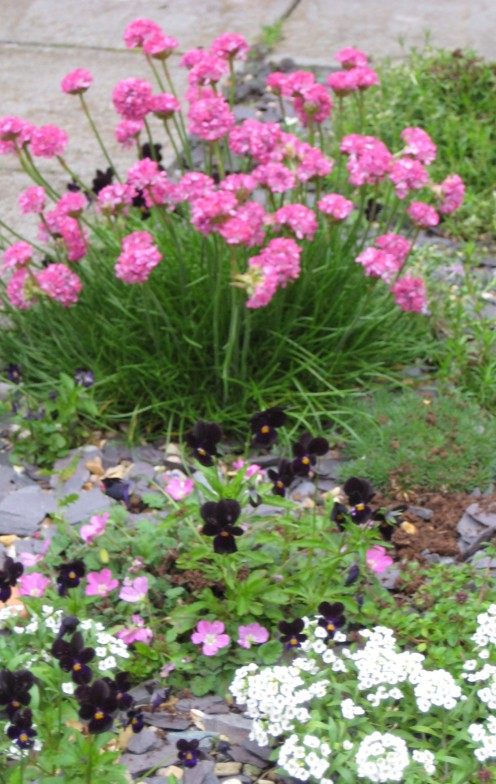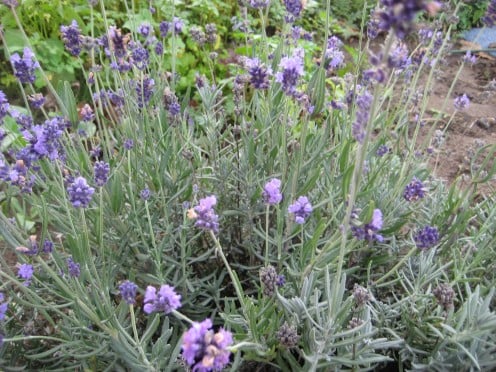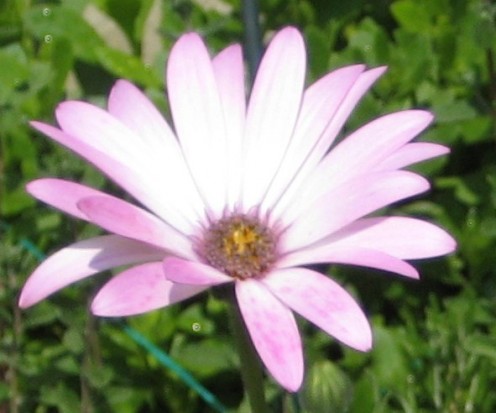Flowers for a Small Garden, with pictures,photos and helpful information.
Penstemon flowers...

allium flowers can be tall but do not take up much space in the garden.

Flowers for a small garden and how to choose them..
Plants to use in small gardens
How to plan what to plant in a small garden plot
When selecting flowers for a small garden you need to take into consideration other factors apart from the obvious ones of the dimensions of the garden and the size that the plants will grow to.
When planning which flowers to use for a small garden also consider -
- Aspect: North,South,East,or West facing - as this will affect how much light your plants get.
Here In my (English) garden the south facing side of the garden gets more light and sunshine while the north facing side is always a cooler and more shaded with less sunny spot for plants.
While on this subject you will also need to think about the shadows that will be cast onto the garden borders by fences, trees and houses and other structures and also keep in mind that this may alter according to the time of day. It is a good idea to view the garden at different times of the day and then mark on a sketched plan of the garden where the light and shade is at different times of the day. This plan will be useful and will help you make decisions in the future.
When buying plants for the garden you will be able to select ones that will suit their location and will thrive in their location.
Plants on sale and even packets of seed will often have a small icon on like a sun and it will show if the plant prefers sun, shade or semi-shade. This will give you an indication of its perfect or almost perfect planting position. You can always research in greater depth if you are 'splashing out cash' on a certain type of specialist plant.
A lot of money can be saved by not making life difficult for the plant by planting it in a totally unsuitable spot in the garden. As you gain confidence in your choice of plants, you will discover that some plants will survive and shall we say tolerate less than perfect conditions.
In the beginning however it is best to play safe and plant your small garden with plants and flowers that will thrive and flourish in the conditions that exist there. This is particularly important in a smaller garden as problems such as shade can be more extreme because you may have no alternative place to use as a planting area. In a large garden the most favourable aspect for plant growth can be selected more easily.
Also the type of soil that exists in your garden needs to be taken into account -
- Consider the soil type i.e. is your garden soil at the extremes of acidity or alkalinity ?
-
Is the soil of a loam, clay or sandy type.
Some plants thrive in acid soil and others in alkaline soil so if you put a plant that needs acid soil in alkaline soil, it will not thrive. Sandy soils will dry out more rapidly than other soil types.
The majority of plants will be fine in the soil that you have in your garden. However, it can make life easier if you have a sandy soil if you use plants that can tolerate drought. A good indicator of what grows well in your soil type is to see what plants grow well in neighbouring gardens. A goodt nursery/garden centre will always be willing to offer advice on this. One of the types of plants that require their own type of preferred soil are heathers which usually require a peaty soil to grow well.
Is the area likely to suffer from drought like conditions in summer or to be water logged in winter?
Thinking about these things before you buy your plants will save you money.
If you fill your garden with plants that do not suit the conditions that you have there is a chance the plants will not survive. If the plants are cheap and annuals then this is not a disaster, you could think of it is a learning process you will know what works and what does not in future years.
However if you are planning to invest in any long term or more expensive plant schemes then any research you do will be a good investment and pay off in terms of saving wasted time,effort and money.
.
Annuals can be grown in pots to add color to the patio area of a small garden.

When selecting plants consider - size, height, colour and textures
The size of area that the plants and flowers will occupy will dictate to a certain extent what plants you will be able to buy and plant in your garden.
- Remember when planning your garden the final size the plants will achieve given time. You may be able to 'shoe horn' a new plant into a space but in three years time when it has grown in height and spread, will you still be happy with your choice in that position ?
Once again this does not apply to annuals as they only last one growing season.
Even in the smallest space it might be a mistake to use just flowers that are short in height or only small plants with small blooms.
- A garden usually needs variety of height,colours and texture.
Colour choice will depend on your own preference when selecting try to have an idea of the effect you are trying to achieve.
It is very easy to be tempted to buy a plant because you like it but try to think about its 'place' in your garden in terms of -
- The 'colour palette' of your garden is it going to harmonise - with exsisting plants ?
- Consider its final height and spread - will it fit into the space?
- Shape and Texture - your garden will look better if you have a variety of foliage/leaf - colour shapes and surfaces. Even the flowers can add to the richness of this with their variety.
- Plant shapes - do they work together ?
Here on this page are featured a selection of plants that could give you ideas to form the basis of a planting plan for a small garden; provided they suit the conditions you have. I have selected easy to grow plants for this article.
Names of plants for growing in a small garden
Here is a list of names and why they are a good idea for planting in a small garden.
Penstemon.
Penstemon flowers are delicate in both their flowers and foliage, so they would fit in well in a small garden. They would add height without being too bulky or causing problems by flopping, as some flowers like delphiniums are prone to. They are of a shape that I think of as 'spires' adding visual height and structure to the form of the garden border. They would be a better choice than foxgloves or hollyhocks in a small garden as the proportions fit into the scale of things better.
Penstemons come in some beautiful shades and some are soft pastel tones while others are of richer hues.
Buy healthy plants and watch out that slugs and snails do not feast on your young plants,as penstemons are not the cheapest of plants to buy.
Sprinkling a gritty substance around the base of the plant may deter the 'night time munchers' otherwise known as slugs. Some people use crushed up egg-shells for this or grit. Delay cutting back of Penstemons until mid-spring rather than in the autumn.
Pansies come in many different colours ...

a viola flower

- Flowers to grow for height in the garden, tall plants for flower borders.
Ideas for tall flowering plants for the garden, with photos. Tall flowering plants are an essential element in some styles of gardening and for adding height and colour to the flower border.
Pansies and Violas ...
Pansies and violas come in a wide range of colours and they are an easy plant to grow from either seed or by buying plug-plants or sometimes as raised plants in trays.
If pansies/violas are purchased or have been grown in a tray, or as plug-plants water them well a couple of hours before you wish to plant them. This will make them easier to remove from their container. They should have a good healthy root system but handle them gently. If they are stuck in their plastic cells squeeze the sides of the cell and ease them out. If they are in a tray and the roots are tangled together ease them apart gently teasing the roots apart rather than tearing them apart.
The colours of pansies range from white through to the rich velvety tones of purple and burgundy. They usually have bi-colours the centres usually being darker. Violas to come in lovely velvety rich colours. There is even a viola that in colour is closer to black than purple it is called Viola 'Bowles Black' . This viola reseeds freely around the garden but is not invasive and is easily removed or transplanted. It looks looking lovely mingling in pleasing combinations with other plants.
Pansies and violas are easy to grow and if you wish to you can raise them from seed but they are not expensive to buy as young plants. I have raised them from seed but often prefer to buy a tray of young plants to fill in the gaps at the front of the borders. This allows me to select the colours and shades that go best and harmonise or contrast with the plants that are already growing there.
Pansies and violas benefit from having the dead flower heads removed - just nip the dead heads off gently with your finger-tips. If left to go th seed you will get less flowers and the plants energy will go into making seed. However if you let them seed at some point you will get new seedlings springing up in your flower bed. The seedlings may be different colours to the original plant, which adds to the fun off gardening.
Aubretia used as an edging plant, with rope topped edging and a gravel path...

When planting pick colours that work well together...

Thrift now comes in forms with variegated leaf colors as well as the traditional variety of thrift plant that is shown here.

A flower suitable for use as an edging plant ...

Aubretia flowers.., make a pretty edging plant.
Aubretia flowers in shades of lilac,purple and mauve. It has a spreading habit but is not invasive, it will happily flop over a path edging such as the rope-top edging in the photo. It is useful to soften the lines of hard-landscaping. It looks very pretty planted next to plants of a similar height and scale. I frequently use it with pansies and thrift for example. Thrift forms a green dome shaped cushion of a plant and flowers in shades of pink. Thrift is also useful as an edging plant. Aubretia is easiest to buy as a plant but it can be raised from seed. Once aubretia is in place in the garden it is best to leave it there as transplanting it can be difficult it is hard to remove sufficient root structure to give the moved plant a chance of surviving.
Cut/trim back the aubretia after the first flush of flowers has ended; if you are lucky you will get another batch of blooms later in the season. Thrift too can be tidied up by trimming it back. Both of these plants should survive several years in the garden if you tidy them as suggested. if you let aubretia run to seed it may exhaust the plant so the clipping back saves this from happening.
Plant dwarf varieties of your favorite plants, such as lavender - Munstead . To use a s a low hedge or a a single plant for frangrance, color and for the bees

Clematis plants are climbers that work well in a small garden, just make sure you buy the right varieties for the space you have.


Plant Osteospermum for flowers throughout the summer months
These plants grow in many variations and colours from the pretty pale pink simple daisy shape version to the fancy shape of the whirly-gig. The plainer ones tend to be more reliable and a bit hardier i.e. more likely to survive the winter. However Osteospermums are not the hardiest of plants and you should not be surprised if you lose them doing the cold winter months. The ones such as whirly-gig types seem to be less hardy in the UK them the type like the one in the photograph. This has been in my garden for a number of years, but I ave never managed to over-winter the fancier variations.
Osteospermums come in shades from pinky-white as in the photo through to magenta and even in creamy yellow shades. They have narrow, green foliage,which is dense once the plant is established. The stems of osteospermums are upright at first but will spread sideways to produce larger clumps of flowers. So if your garden is extremely small this may not be one for you to grow.
In a small garden if the survive for long enough the plant may start to take up too much space. Although if you are brave (some may say foolish) and willing to take a chance, I have cut into and hacked back clumps of this and they have survived the insult.
N.B. If I am concerned I will lose a plant that I am doing this to I cut it back to a point where I can see it can regenerate and only do half the plant at a time. I mean I cut back the left or right side of the plant or the front or the back, leaving half of it untouched. Once it has started to regrow I then cut back the other half. Not a conventional way of dealing with plants and it looks a bit odd for a while but it works in my garden.
The osteospermum flowers are produced in abundance all summer and often into early autumn.
a place to read about flowers for the garden
- Pictures of Flowers, a pictorial guide.
Here is a pictorial guide to flowers for the garden also by 2uesday. This includes short articles on the topic of flowers and gardens and lots of photos of flowers. This page is being updated with extra flower photo and articles weekly.
Ideas for planting a small courtyard garden...
- Flowers for a small courtyard Garden. With pictures of flowers and plants.
As with planning most types of garden often the easiest starting point is to think about the factors that exist and cannot be altered. These may be areas of the garden that are in shade or part-shade. ...
Easy to grow flower seeds... link...
- Flower Seeds. That are easy to grow.
Here are the names of flower seeds that are easy to grow from seed. They are annuals which means that they will flower in the same year as you sow the seeds. Although they are easy to grow and usually...
- English Country Garden. Beautiful photographs of fl...
A collection of flower photographs taken in a English country/cottage style garden in summer time, some growing well in partial shade








